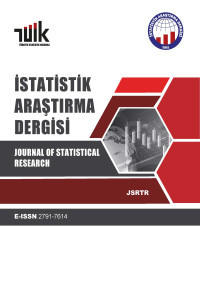Çok Değişkenli Kalite Kontrol Yaklaşımlarının Bir Değerlendirmesi
Çok Değişkenli Kalite Kontrol, Hotelling T2, Kalite Kontrol
An Assessment of Multivariate Quality Control Approaches
Multivariate Quality Control, Hotelling T2, Quality Control,
___
- HAWKİNS D. M., (1991), Multivariate quality control based on regression-adjusted variables, Techonometrics, 33, 61-75.
- HAWKİNS D. M., ve BRADU (1990), Application of the Moore-Penrose invers of a data matrix in multiple regression, Linear algebra and its applications, 127, 403-426.
- HAWKİNS D. M., and WİXLEY R.A.J. (1986), A note on the transformation of Chi-squared variables to normality, The American Statistician, 40, 296-298.
- HOTELLING H., (1947), Multivariate Quality Control, Techniques of Statistical Analysis, (Ed. C. Eisenhart, M.W. Hastay, and W.A. Wallis, McGraw-Hill, New York, s. 84-111.
- JACKSON J.E., (1959), Quality control methods for several related variables, Technometrics, 1, 359-377.
- MASON R. L., TRACY N. D. and YOUNG J. C., (1995), Decomposition of T2 For Multivariate control chart interpretation, Journal Of Quality Technology, 27, 99-108.
- TRACY, N. D., YOUNG J.C., ve MASON R., (1995), A bivariate control chart for paired measurements, Journal of Quality Technology, 27, 4, 370-376.
- MONTGOMERY, DOUGLAS C., (1991), Introduction to Statistical Quality Control, 322-332.
- MURPY, B. J., (1987), Selecting out of control variables with the T2 multivariate quality control procedure, The Statistician, 36, 571-583.
- RAVEH A., (1985), On the use of the inverse of the correlation Matrix in multivariate data analysis, The American Statistician, 39, 39-42.
- RENCHER A.C., (1993), The contribution of individual variables to hotelling T2, Wilks’ A, and R2 . Biometrics, 49, 479-489.
- SCHALL, S. and CHANDRA J., (1987), Multivariate quality control using principal components, Int. J. of Prod. Res., 25, 571-588.
- WEİSBERG, S., (1985), Applied Linear Regression (2nd ed.), Newyork, John Wiley.
- ISSN: 1303-6319
- Başlangıç: 2002
- Yayıncı: TÜİK
Çok Değişkenli Kalite Kontrol Yaklaşımlarının Bir Değerlendirmesi
Mehmet Akif BAKIR, Sezar KARACA
Bir Yatırım Problemine Analitik Hiyerarşi Prosesi Yönteminin Uygulanması
Yavuz UYAR, Ercument Neset DIZDAR, Mustafa KURT
Oransal ve Çarpımsal Tahmin Ediciler
Basılı Türkçe’nin Önemli Bazı İstatistiksel Özellikleri
Mehmet Emin DALKILIÇ, Gökhan DALKILIÇ
Ardışık Örnekleme Planında Cusum Kontrol Katlarının Kullanımı
Canan HAMURKAROĞLU, Sevil BACANLI
Deney Tasarımında Kesirli Çoketkenli Tasarımlar ve Uygulamaları
Üç Yönlü Tablolarda X2 İstatistiğinin Kullanılması
Tiroit Bezi Verilerinin Bayes ve En Yakın K-Komşu Gibi Eğiticili Yöntemlerle Sınıflanması
Bernoulli Sayıları ve Lojistik Dağılış Fonksiyonu Üzerine Bir Çalışma
